-

 Superb Smithwicks sponsored team photograph of the 1981 All Ireland Hurling Champions -Offaly.The authenticity of this print and its worn appearance makes for an excellent addition to any GAA wall collection. 32cm x 47cm. Birr Co Offaly The 1981 All Ireland Hurling Final was the 94th All-Ireland Final and the culmination of the 1981 All-Ireland Senior Hurling Championship, an inter-county hurling tournament for the top teams in Ireland. The match was held at Croke Park, Dublin, on 6 September 1981, between Galway and Offaly. The reigning champions lost to their Leinster opponents, who won their first ever senior hurling title, on a score line of 2-12 to 0-15. Johnny Flaherty scored a handpassed goal in this game; this was before the handpassed goal was ruled out of the game as hurling's technical standards improved.
Superb Smithwicks sponsored team photograph of the 1981 All Ireland Hurling Champions -Offaly.The authenticity of this print and its worn appearance makes for an excellent addition to any GAA wall collection. 32cm x 47cm. Birr Co Offaly The 1981 All Ireland Hurling Final was the 94th All-Ireland Final and the culmination of the 1981 All-Ireland Senior Hurling Championship, an inter-county hurling tournament for the top teams in Ireland. The match was held at Croke Park, Dublin, on 6 September 1981, between Galway and Offaly. The reigning champions lost to their Leinster opponents, who won their first ever senior hurling title, on a score line of 2-12 to 0-15. Johnny Flaherty scored a handpassed goal in this game; this was before the handpassed goal was ruled out of the game as hurling's technical standards improved. -

 25cm x 20cm Abbeyfeale Co Limerick Nice souvenir of the iconic photograph taken by Justin Nelson.The following explanation of the actual verbal exchange between the two legends comes from Michael Moynihan of the Examiner newspaper. "When Christy Ring left the field of play injured in the 1957 Munster championship game between Cork and Waterford at Limerick, he strolled behind the goal, where he passed Mick Mackey, who was acting as umpire for the game. The two exchanged a few words as Ring made his way to the dressing-room.It was an encounter that would have been long forgotten if not for the photograph snapped at precisely the moment the two men met. The picture freezes the moment forever: Mackey, though long retired, still vigorous, still dark haired, somehow incongruous in his umpire’s white coat, clearly hopping a ball; Ring at his fighting weight, his right wrist strapped, caught in the typical pose of a man fielding a remark coming over his shoulder and returning it with interest. Two hurling eras intersect in the two men’s encounter: Limerick’s glory of the 30s, and Ring’s dominance of two subsequent decades.But nobody recorded what was said, and the mystery has echoed down the decades.But Dan Barrett has the answer.He forged a friendship with Ring from the usual raw materials. They had girls the same age, they both worked for oil companies, they didn’t live that far away from each other. And they had hurling in common.We often chatted away at home about hurling,” says Barrett. “In general he wouldn’t criticise players, although he did say about one player for Cork, ‘if you put a whistle on the ball he might hear it’.” Barrett saw Ring’s awareness of his whereabouts at first hand; even in the heat of a game he was conscious of every factor in his surroundings. “We went up to see him one time in Thurles,” says Barrett. “Don’t forget, people would come from all over the country to see a game just for Ring, and the place was packed to the rafters – all along the sideline people were spilling in on the field. “He came out to take a sideline cut at one stage and we were all roaring at him – ‘Go on Ring’, the usual – and he looked up into the crowd, the blue eyes, and he looked right at me. “The following day in work he called in and we were having a chat, and I said ‘if you caught that sideline yesterday, you’d have driven it up to the Devil’s Bit.’ “There was another chap there who said about me, ‘With all his talk he probably wasn’t there at all’. ‘He was there alright,’ said Ring. ‘He was over in the corner of the stand’. He picked me out in the crowd.” “He told me there was no way he’d come on the team as a sub. I remember then when Cork beat Tipperary in the Munster championship for the first time in a long time, there was a helicopter landed near the ground, the Cork crowd were saying ‘here’s Ring’ to rise the Tipp crowd. “I saw his last goal, for the Glen against Blackrock. He collided with a Blackrock man and he took his shot, it wasn’t a hard one, but the keeper put his hurley down and it hopped over his stick.” There were tough days against Tipperary – Ring took off his shirt one Monday to show his friends the bruising across his back from one Tipp defender who had a special knack of letting the Corkman out ahead in order to punish him with his stick. But Ring added that when a disagreement at a Railway Cup game with Leinster became physical, all of Tipperary piled in to back him up. One evening the talk turned to the photograph. Barrett packed the audience – “I had my wife there as a witness,” – and asked Ring the burning question: what had Mackey said to him? “’You didn’t get half enough of it’, said Mackey. ‘I’d expect nothing different from you,’ said Ring. “That was what was said.” You might argue – with some credibility – that learning what was said by the two men removes some of the force of the photograph; that if you remained in ignorance you’d be free to project your own hypothetical dialogue on the freeze-frame meeting of the two men. But nothing trumps actuality. The exchange carries a double authenticity: the pungency of slagging from one corner and the weariness of riposte from the other. Dan Barrett just wanted to set the record straight. “I’d heard people say ‘it will never be known’ and so on,” he says.“I thought it was no harm to let people know.” No harm at all" Origins ; Co Limerick Dimensions : 31cm x 25cm 1kgBorn in Castleconnell, County Limerick,Mick Mackey first arrived on the inter-county scene at the age of seventeen when he first linked up with the Limerick minor team, before later lining out with the junior side. He made his senior debut in the 1930–31 National League. Mackey went on to play a key part for Limerick during a golden age for the team, and won three All-Ireland medals, five Munster medals and five National Hurling League medals. An All-Ireland runner-up on two occasions, Mackey also captained the team to two All-Ireland victories. His brother, John Mackey, also shared in these victories while his father, "Tyler" Mackey was a one-time All-Ireland runner-up with Limerick. Mackey represented the Munster inter-provincial team for twelve years, winning eight Railway Cup medals during that period. At club level he won fifteen championship medals with Ahane. Throughout his inter-county career, Mackey made 42 championship appearances for Limerick. His retirement came following the conclusion of the 1947 championship. In retirement from playing, Mackey became involved in team management and coaching. As trainer of the Limerick senior team in 1955, he guided them to Munster victory. He also served as a selector on various occasions with both Limerick and Munster. Mackey also served as a referee. Mackey is widely regarded as one of the greatest hurlers in the history of the game. He was the inaugural recipient of the All-Time All-Star Award. He has been repeatedly voted onto teams made up of the sport's greats, including at centre-forward on the Hurling Team of the Centuryin 1984 and the Hurling Team of the Millennium in 2000. Origins : Co Limerick Dimensions : 28cm x 37cm 1kg
25cm x 20cm Abbeyfeale Co Limerick Nice souvenir of the iconic photograph taken by Justin Nelson.The following explanation of the actual verbal exchange between the two legends comes from Michael Moynihan of the Examiner newspaper. "When Christy Ring left the field of play injured in the 1957 Munster championship game between Cork and Waterford at Limerick, he strolled behind the goal, where he passed Mick Mackey, who was acting as umpire for the game. The two exchanged a few words as Ring made his way to the dressing-room.It was an encounter that would have been long forgotten if not for the photograph snapped at precisely the moment the two men met. The picture freezes the moment forever: Mackey, though long retired, still vigorous, still dark haired, somehow incongruous in his umpire’s white coat, clearly hopping a ball; Ring at his fighting weight, his right wrist strapped, caught in the typical pose of a man fielding a remark coming over his shoulder and returning it with interest. Two hurling eras intersect in the two men’s encounter: Limerick’s glory of the 30s, and Ring’s dominance of two subsequent decades.But nobody recorded what was said, and the mystery has echoed down the decades.But Dan Barrett has the answer.He forged a friendship with Ring from the usual raw materials. They had girls the same age, they both worked for oil companies, they didn’t live that far away from each other. And they had hurling in common.We often chatted away at home about hurling,” says Barrett. “In general he wouldn’t criticise players, although he did say about one player for Cork, ‘if you put a whistle on the ball he might hear it’.” Barrett saw Ring’s awareness of his whereabouts at first hand; even in the heat of a game he was conscious of every factor in his surroundings. “We went up to see him one time in Thurles,” says Barrett. “Don’t forget, people would come from all over the country to see a game just for Ring, and the place was packed to the rafters – all along the sideline people were spilling in on the field. “He came out to take a sideline cut at one stage and we were all roaring at him – ‘Go on Ring’, the usual – and he looked up into the crowd, the blue eyes, and he looked right at me. “The following day in work he called in and we were having a chat, and I said ‘if you caught that sideline yesterday, you’d have driven it up to the Devil’s Bit.’ “There was another chap there who said about me, ‘With all his talk he probably wasn’t there at all’. ‘He was there alright,’ said Ring. ‘He was over in the corner of the stand’. He picked me out in the crowd.” “He told me there was no way he’d come on the team as a sub. I remember then when Cork beat Tipperary in the Munster championship for the first time in a long time, there was a helicopter landed near the ground, the Cork crowd were saying ‘here’s Ring’ to rise the Tipp crowd. “I saw his last goal, for the Glen against Blackrock. He collided with a Blackrock man and he took his shot, it wasn’t a hard one, but the keeper put his hurley down and it hopped over his stick.” There were tough days against Tipperary – Ring took off his shirt one Monday to show his friends the bruising across his back from one Tipp defender who had a special knack of letting the Corkman out ahead in order to punish him with his stick. But Ring added that when a disagreement at a Railway Cup game with Leinster became physical, all of Tipperary piled in to back him up. One evening the talk turned to the photograph. Barrett packed the audience – “I had my wife there as a witness,” – and asked Ring the burning question: what had Mackey said to him? “’You didn’t get half enough of it’, said Mackey. ‘I’d expect nothing different from you,’ said Ring. “That was what was said.” You might argue – with some credibility – that learning what was said by the two men removes some of the force of the photograph; that if you remained in ignorance you’d be free to project your own hypothetical dialogue on the freeze-frame meeting of the two men. But nothing trumps actuality. The exchange carries a double authenticity: the pungency of slagging from one corner and the weariness of riposte from the other. Dan Barrett just wanted to set the record straight. “I’d heard people say ‘it will never be known’ and so on,” he says.“I thought it was no harm to let people know.” No harm at all" Origins ; Co Limerick Dimensions : 31cm x 25cm 1kgBorn in Castleconnell, County Limerick,Mick Mackey first arrived on the inter-county scene at the age of seventeen when he first linked up with the Limerick minor team, before later lining out with the junior side. He made his senior debut in the 1930–31 National League. Mackey went on to play a key part for Limerick during a golden age for the team, and won three All-Ireland medals, five Munster medals and five National Hurling League medals. An All-Ireland runner-up on two occasions, Mackey also captained the team to two All-Ireland victories. His brother, John Mackey, also shared in these victories while his father, "Tyler" Mackey was a one-time All-Ireland runner-up with Limerick. Mackey represented the Munster inter-provincial team for twelve years, winning eight Railway Cup medals during that period. At club level he won fifteen championship medals with Ahane. Throughout his inter-county career, Mackey made 42 championship appearances for Limerick. His retirement came following the conclusion of the 1947 championship. In retirement from playing, Mackey became involved in team management and coaching. As trainer of the Limerick senior team in 1955, he guided them to Munster victory. He also served as a selector on various occasions with both Limerick and Munster. Mackey also served as a referee. Mackey is widely regarded as one of the greatest hurlers in the history of the game. He was the inaugural recipient of the All-Time All-Star Award. He has been repeatedly voted onto teams made up of the sport's greats, including at centre-forward on the Hurling Team of the Centuryin 1984 and the Hurling Team of the Millennium in 2000. Origins : Co Limerick Dimensions : 28cm x 37cm 1kg -

 50cm x 70cm Drumcondra Dublin Once the Willy Wonka chocolate factory of Dublin,Williams & Woods kept generations of children and adults happy with their large range of confectionary items as advertised in this rare, original print from the late 1890s.The company is long gone but happily the building has been put to good use as you can read below.William's & Woods building on King's Inn Street in Dublin City Centre is where it all began - the first home to the Chocolate Factory shared creative space. Once manufacturing various sweet treats including Toblerone and Mint Crisp, this industrial building now houses an eclectic mix of small businesses and individuals in creative sectors including art, design, music, photography, craft, up-cycling, dance, illustration, graphics, events, horticulture, baking and small batch food & drink production. The incredible transformation and re-invention of Dublin's first concrete building into a creative and collaborative space continues in addition to other alternative Chocolate Factory venues around the country.
50cm x 70cm Drumcondra Dublin Once the Willy Wonka chocolate factory of Dublin,Williams & Woods kept generations of children and adults happy with their large range of confectionary items as advertised in this rare, original print from the late 1890s.The company is long gone but happily the building has been put to good use as you can read below.William's & Woods building on King's Inn Street in Dublin City Centre is where it all began - the first home to the Chocolate Factory shared creative space. Once manufacturing various sweet treats including Toblerone and Mint Crisp, this industrial building now houses an eclectic mix of small businesses and individuals in creative sectors including art, design, music, photography, craft, up-cycling, dance, illustration, graphics, events, horticulture, baking and small batch food & drink production. The incredible transformation and re-invention of Dublin's first concrete building into a creative and collaborative space continues in addition to other alternative Chocolate Factory venues around the country.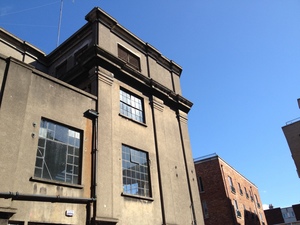
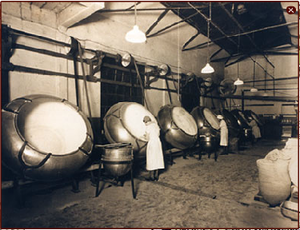
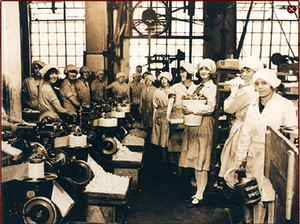
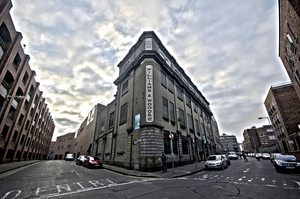 D
D
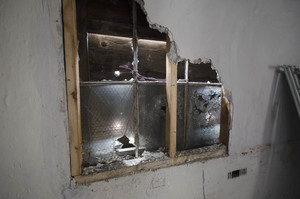
-

 Charming 1940s advert from the merchant bottler Wm Kearney & Sons Limerick City.These bottling merchants would bottle for the major brands such as Jamesons and Bushmills and very often would distill their own single malt whiskey as well, usually for the local market.The "real Irish beauty " featured smoking a cigarette certainly added to the allure of the Wm Kearney brand ! Doon Co Limerick 56cm x 50cm
Charming 1940s advert from the merchant bottler Wm Kearney & Sons Limerick City.These bottling merchants would bottle for the major brands such as Jamesons and Bushmills and very often would distill their own single malt whiskey as well, usually for the local market.The "real Irish beauty " featured smoking a cigarette certainly added to the allure of the Wm Kearney brand ! Doon Co Limerick 56cm x 50cm -
Out of stock
 John Skelton was born in Armagh in 1925. A very talented artist who delighted in portraying the ordinary men and women of Rural Ireland, his works are on permanent display in the Joyce Collection of Northwestern University of Illinois,the headquarters of the ESB,Bank of Ireland and the Embassy of South Korea. Skelton started his professional career in London, where he came under influence of Euston Road School in the late 1940s. In 1946 he married Caroline, settling four years later in Dublin. He worked initially in advertising as Art Director and illustrator of books, most of them educational. After 1975 he worked full-time as a painter. He had numerous one man shows in Dublin; two in Belfast, one in Los Angeles and one in the Mystic Seaport Museum in Connecticut. Up to the late 1980s, Skelton was a frequent exhibitor in group shows, particularly the annual Royal Hibernian Academy and the Watercolour Society shows in Dublin. In recent years, however, his work was in such demand that he contributed to these less often. During the 1970s and earlier 1980s he earned a reputation as a gifted teacher and lecturer in the National College of Art and Design in Dublin. John Skelton's grave can be found at Mount Jerome Cemetery, Harold's Cross, Dublin, Ireland. Origins:Co Mayo Dimensions :29cm x 36cm
John Skelton was born in Armagh in 1925. A very talented artist who delighted in portraying the ordinary men and women of Rural Ireland, his works are on permanent display in the Joyce Collection of Northwestern University of Illinois,the headquarters of the ESB,Bank of Ireland and the Embassy of South Korea. Skelton started his professional career in London, where he came under influence of Euston Road School in the late 1940s. In 1946 he married Caroline, settling four years later in Dublin. He worked initially in advertising as Art Director and illustrator of books, most of them educational. After 1975 he worked full-time as a painter. He had numerous one man shows in Dublin; two in Belfast, one in Los Angeles and one in the Mystic Seaport Museum in Connecticut. Up to the late 1980s, Skelton was a frequent exhibitor in group shows, particularly the annual Royal Hibernian Academy and the Watercolour Society shows in Dublin. In recent years, however, his work was in such demand that he contributed to these less often. During the 1970s and earlier 1980s he earned a reputation as a gifted teacher and lecturer in the National College of Art and Design in Dublin. John Skelton's grave can be found at Mount Jerome Cemetery, Harold's Cross, Dublin, Ireland. Origins:Co Mayo Dimensions :29cm x 36cm -

 32cm x 25cm Charles Stewart Parnell (1846-1891) will be remembered as one of the most iconic and indeed controversial politicians in Irish history.MP and Leader of the Irish Parliamentary or Home Rule Party from1882 to 1891 until revelations of his adulterous love affair with Kitty O'Shea forced his resignation.He died shortly afterwards from pneumonia in the arms of his newly divorced and remarried wife Katherine.His death was considered to be a direct result of the stresses he endured because of the Victorian era scandal and his subsequent funeral at Glasnevin Cemetery in Dublin was attended by more than 200000 people.His notability was such that his gravestone of unhewn Wicklow granite, erected in 1940,reads only Parnell. This faithful portrayal of Parnell,well over 130 years old, by the artist JG Wills dates to 1884 and is a beautiful homage to the "uncrowned king of Ireland".
32cm x 25cm Charles Stewart Parnell (1846-1891) will be remembered as one of the most iconic and indeed controversial politicians in Irish history.MP and Leader of the Irish Parliamentary or Home Rule Party from1882 to 1891 until revelations of his adulterous love affair with Kitty O'Shea forced his resignation.He died shortly afterwards from pneumonia in the arms of his newly divorced and remarried wife Katherine.His death was considered to be a direct result of the stresses he endured because of the Victorian era scandal and his subsequent funeral at Glasnevin Cemetery in Dublin was attended by more than 200000 people.His notability was such that his gravestone of unhewn Wicklow granite, erected in 1940,reads only Parnell. This faithful portrayal of Parnell,well over 130 years old, by the artist JG Wills dates to 1884 and is a beautiful homage to the "uncrowned king of Ireland". -
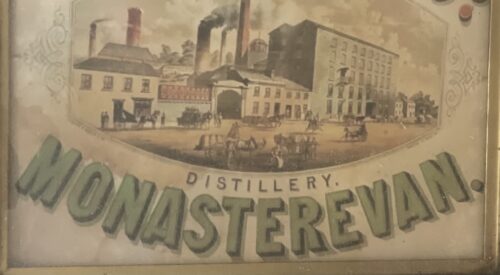
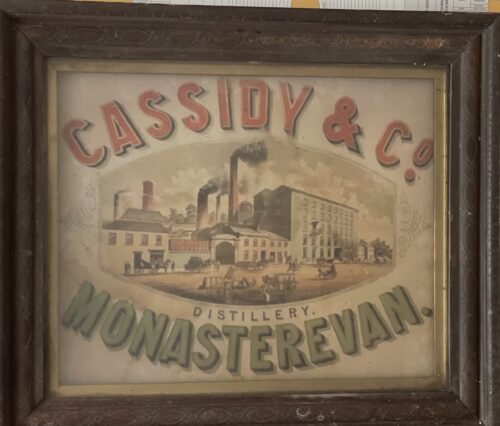 67cm x 56cm
67cm x 56cmIn 1784 Monasterevin Distillery was opened by Mr. John Cassidy. A hundred years later, in 1884 the distillery was making 250,000 gallons of whiskey a year. It was said that the "Cassidy whiskey was the best whiskey in the country".
Some of the whiskey was exported to London. It was transported to Dublin on canal boats and then shipped to England from Dublin Port. A brewery for making beer was later opened in 1860. Cassidy's Distillery and Brewery closed in 1934.
The Cassidy Family lived in Monasterevin House. They were friendly with Gerard Manley Hopkins, the famous poet. He stayed with them when he visited Monasterevin.
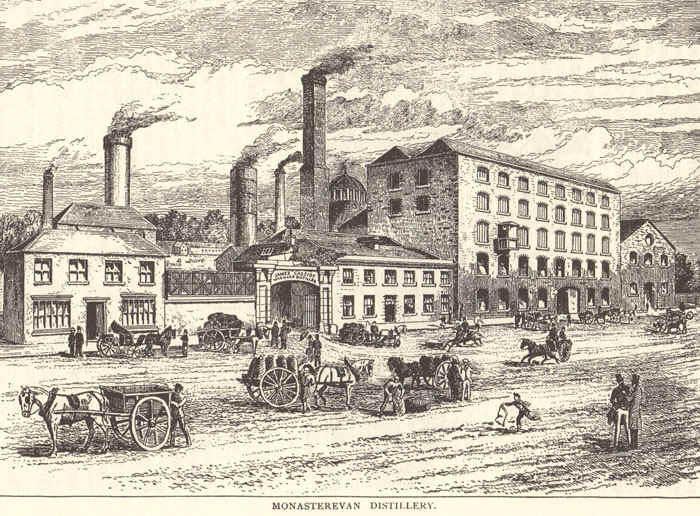
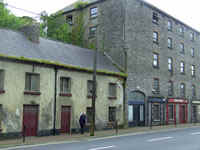
-

 48cm x 38cm The Shelbourne Hotel is a historic hotel in Dublin, Ireland, situated in a landmark building on the north side of St Stephen's Green. Currently owned by Kennedy Wilsonand operated by Marriott International, the hotel has 265 rooms in total and reopened in March 2007 after undergoing an eighteen-month refurbishment.
48cm x 38cm The Shelbourne Hotel is a historic hotel in Dublin, Ireland, situated in a landmark building on the north side of St Stephen's Green. Currently owned by Kennedy Wilsonand operated by Marriott International, the hotel has 265 rooms in total and reopened in March 2007 after undergoing an eighteen-month refurbishment.History
The Shelbourne Hotel was founded in 1824 by Martin Burke, a native of Tipperary, when he acquired three adjoining townhousesoverlooking Stephen's Green, Europe's largest garden square. Burke named his grand new hotel The Shelbourne, after William Petty, 2nd Earl of Shelburne. William Makepeace Thackeray was an early guest, staying in 1842 and including a piece about the Shelbourne in The Irish Sketch-Book (1843). In the early 1900s, Alois Hitler jr., the elder half-brother of Adolf Hitler, worked in the hotel while in Dublin. During the 1916 Easter Rising the hotel was occupied by 40 British troops under Captain Andrews to counter the Irish Citizen Armyand Irish Volunteer forces, commanded by Michael Mallin, who had occupied Stephen's Green. In 1922, the Constitution of the Irish Free State was drafted in room 112, now known as The Constitution Room. The facade was refurbished in 2016, winning an award from the Irish Georgian Society. In December 2018 UEFA's executive committee made the draw for the 2019 UEFA Nations League Finals in the hotel.Statues
A major redesign by John McCurdy was completed in 1867, with the Foundry of Val d'Osne casting the four external caryatid style torchère statues. These were based on two repeated beaux-arts neoclassical models originally sculpted by the prolific French sculptor Mathurin Moreau entitled Égyptienne – the two female Ancient Egyptianfigures flanking either side of the front door, and Négresse – the two female ancient Kushite (Nubian)figures flanking either corner of the main building. All four statues are wearing gold coloured anklets, and are draped, with jewellery picked out in gilt while supporting a torch with a frosted glass flambeau shade.All four statues are on a circular base with a further square metal plinth with cartouches to the angles indicating royal descent. In feint writing at the front of the circular base of all four statues can be seen the name of the foundry which produced the statues Val d'Osne. Of the several other examples of the castings, the most notable can be seen in the porch of the hôtel de ville (town hall) in the French town of Remiremont as well as outside the mausoleum of the architect Temple Hoyne Buellin Denver, Colorado and in the Jardins do Palácio de Cristal in Porto.In all three cases the door is flanked either side by one Égyptienne and one Négresse statue indicating parity. In July 2020, the statues at the front of the building were removed by management as a precautionary response to the toppling and removal of statues following the murder of George Floyd and Black Lives Matter protests. This move resulted from the belief that either two or all four of the statues represented Nubian slaves shown in manacles. Both histories of the hotel, that of 1951 by Elizabeth Bowen and that of 1999 by Michael O'Sullivan, state that two of the statues represent slaves or servants, with Bowen stating "on each stands a female statue, Nubian in aspect, holding a torch shaped lamp". Kyle Leyden, an art historian at the Courtauld Institute, argued that none of the statues are of the established "Nubian slave" type, and that all four figures wear ankletsindicating aristocratic status, rather than shackles.After an examination by Paula Murphy, an art historian at University College Dublin, concluded that the statues were not representations of slaves, it was announced that they would be restored to their plinths.After being cleaned, they were reinstalled on the night of 14 December. In James Joyce's Ulysses, Leopold Bloom remembers the Shelbourne as where "Mrs Miriam Dandrade", a "Divorced Spanish American" sold him "her old wraps and black underclothes -

 40cm x 33cm Co Cork
40cm x 33cm Co CorkEvery country has its own slang terms or local colloquialisms and Ireland is no different. Many of the country's famous sayings are well-known worldwide, but there may be one or two you're not familiar with. No doubt you'll be wanting to experience the 'craic' for yourself as you explore your new surroundings, so we've put together this 'bang-on' guide to the local lingo!
Craic is probably the most popular and familiar slang phrase, simply meaning ‘fun’ or ‘banter’, just good times. It has origins with the Ulster Scots, who told of the crack, the Gaelic spelling not fully popularised in Ireland until the 1970s, when it was the catchphrase of the Irish-language TV show SBB ina Shuí.
Some other slang phrases might not be quite as familiar, and each region of Ireland has its own particular lingo, but here are some of the weird and wonderful words and phrases that might come in handy, and save you from making an eejit or a gowl of yourself!Gowl: An annoying person. Ah, ye GOW-EL ye!
Wisht: Shush! A handy one for in the cinema, or for chatterboxes in lectures.
Scarlet: Embarrassed. Hopefully not because you’ve been a gowl. I was such an eejit, I was scarlet!
Wired to the moon: Maybe you’ve been out late, enjoying the craic a little too much, and you’ve grabbed a triple espresso on the way to the lecture theatre? You’re wired to the moon.
Wee: Small, but everything in Ireland is wee. If Dwayne ‘The Rock’ Johnson were to visit Ireland, he’d be Wee Dwayne.
Quare: Meaning ‘great’. It’s quare weather out today! Also used for ‘very’. It’s quare warm today!
Savage: Something excellent. Was it a good craic last night? Oh, it was savage!
The Jacks: The toilets, fir jacks for the mens, ban jacks for the ladies, not to be confused with…
Banjaxed: Broken. Ruined.
Happy out: Simply happy. You’re enjoying the craic, having a quare old time, you’re happy out.
Sure look at it: A suitable reply to nearly any statement. Isn’t this weather grand? Ah, sure look at it!
Ossified: Very drunk. Regretfully so. See also: langers, blathered, locked.
The messages: If you hear people referring to doing the messages, they're going shopping. Does anyone need anything? I’m heading out to do the messages.
The press: An Irish term for the cupboard. You might want to check you’ve enough biscuits in the press, before you set off to do the messages.
Are you okay?: If the barman is asking you this, he’s not checking on your state of being, simply wanting to know what you want to order.
I’ve a throat on me: Thirsty. Just don’t get too ossified and make an eejit of yourself!
Me ould segotia, me ould sweat, me ould flower: Best friend.
Aculsha: An old term of affection, from a chuisle mo chroí, ‘pulse of my heart’
A soft day: A drizzly rainy, misty day.
Acting the maggot: Being silly, making a nuisance. An annoying person.
Making a bags of it: Making a mess of something.
Cat altogether: Something bad. If the weather is terrible, it could be cat altogether out there.
Even if you’re apprehensive about using some of these phrases in your conversations, it’ll certainly help you understand what your new Irish friends are saying. Ah, it was quare warm yesterday, I’d meant to do the messages, but I’d quite the throat on me. I got utterly langers, made a right gowl of meself acting the maggot, and I’m totally banjaxed today. Savage! -

 57cm x 70cm Co Tipperary
57cm x 70cm Co TipperaryThe most haunting and poignant image of Irish involvement in the first World War is at the centre of an unsolved art mystery.
The Last General Absolution of the Munsters at Rue du Bois – a painting long presumed lost – depicts soldiers of the Royal Munster Fusiliers regiment receiving “general absolution” from their chaplain on the eve of battle in May 1915. Most of them died within 24 hours.
The painting, by Italian-born war artist Fortunino Matania, became one of the most famous images of the war when prints of it were published in illustrated weekly newspapers.
Copies hung in houses & pubs throughout Ireland, and especially Munster, but, as Irish public opinion towards the war changed, the picture gradually disappeared from view.A copy still hangs in the famous pub Larkins of Garrykennedy Co Tipperary to this day.
Centenary commemorations of the first World War have prompted renewed interest in the whereabouts of the original painting among art and military historians.
A widely held theory that the painting was lost when archives were destroyed in a fire during the blitz of London in 1940 is “very much” doubted by English historian Lucinda Gosling, who is writing a book about the artist.
She told The Irish Times there was no definitive proof to confirm this theory and it was possible the original painting was still “out there”.
The painting could, conceivably, be in private hands or, more improbably, be lying forgotten or miscatalogued in a museum’s storage area. Matania’s work occasionally turns up at art auctions, but there has been no known or publicly-documented sighting of the original Munsters painting.
Ms Gosling described Matania as an artist “able to work at great speed, producing pictures that were unnervingly photographic in their realism”.
His pictures, she said, had “reached and influenced millions” and “he combined skill and artistry with a strong streak of journalistic tenacity”.
Wayside shrine
The painting is based on an event that took place on Saturday evening, May 8th, 1915.Soldiers from the Second Battalion, Royal Munster Fusiliers, commanded by Lieut-Col Victor Rickard, paused beside a wayside shrine near the village of Rue du Bois in northwest France. The following day, they were due to go into battle, in what became known as the Battle of Aubers Ridge.The painting is imbued with a sense of impending doom.
In Catholic canon law, a priest may grant general absolution of sin to a gathering of the faithful where there is imminent danger of death and no time for individual confessions.
The ritual was used on September 11th, 2001, in New York to grant general absolution to police officers and firefighters about to enter the Twin Towers of the World Trade Centre.In the painting, the Irish chaplain Fr Francis Gleeson is shown blessing the men: “Misereatur vestri omnipotens Deus; et dimissis omnibus peccatis vestris, perducat vos Iesus Christus ad vitam aeternam” (May Almighty God have mercy on you, and having forgiven all your sins, may Jesus Christ bring you to life everlasting).
The men then sang the hymns Te Deum and Hail Glorious St Patrick.
The artist was not present at the scene but based his painting on a written account by Lieut- Col Rickard’s widow, Jessie, who is believed to have commissioned the painting in memory of her husband.
She had gathered eye-witness accounts from survivors and wrote: “There are many journeys and many stopping- places in the strange pilgrimage we call life, but there is no other such journey in the world as the journey up a road on the eve of battle, and no stopping- place more holy than a wayside shrine.”
She noted among the troops were “lads from Kerry and Cork, who, a year before, had never dreamed of marching in the ranks of the British army”.
After Fr Gleeson’s blessing, she wrote: “The regiment moved on, and darkness fell as the skirl of the Irish pipes broke out, playing a marching tune.“The Munsters were wild with enthusiasm; they were strong with the invincible strength of faith and high hope, for they had with them the vital conviction of success, the inspiration that scorns danger – which is the lasting heritage of the Irish; theirs still and theirs to remain when great armaments and armies and empires shall be swept away, because it is immovable as the eternal stars.”
Mown down
The following morning, Sunday May 9th, most of the Irish soldiers were mown down by German gunfire and shelling.
On a catastrophic day for the British army – over 11,000 casualties – the Royal Munster Fusiliers suffered dreadful losses. Exact estimates vary, but one account records 800 Munsters went into battle and only 200 assembled that evening.
Mrs Rickard concluded : “So the Munsters came back after their day’s work; they formed up again in the Rue du Bois, numbering 200 men and three officers. It seems almost superfluous to make any further comment.”
The Last General Absolution of the Munsters at Rue du Bois
The Painting
The Last General Absolution of the Munsters at Rue du Bois shows some of the hundreds of soldiers from the second battalion of the Royal Munster Fusiliers who gathered at a shrine near the village of Rue du Bois on the western front on Saturday, May 8th, 1915.
The image was published in the London illustrated weekly newspaper The Sphere in November 1916, and in 1917 in the Weekly Freeman’s, an Irish publication. There are copies of the print in various museums and in private ownership in Ireland and Britain.
The Artist
Fortunino Matania, (1881- 1963) was born in Naples and was a well-known artist and illustrator in Italy before moving to London in 1902. He worked for The Sphere – an illustrated weekly newspaper – and became famous for depicting the sinking of the Titanic in 1912.
He was an official war artist in the first World War and his graphic illustrations of trench warfare were highly renowned.
The Location
Rue du Bois is located near the village of Neuve Chapelle in the Nord-Pas-de-Calais region of France close to the border with Belgium. According to the Royal Munster Fusiliers Association, the original shrine has long gone.
The Chaplain
Depicted on horseback, with hand raised granting general absolution, is Fr Francis Gleeson, a native of Templemore, Co Tipperary. He was ordained a priest in Maynooth in 1910 and volunteered to serve as a chaplain in the army at the outbreak of the war. He was assigned to the Royal Munster Fusiliers and served with distinction. He survived the war and returned to Ireland where he worked as priest in Dublin and died in 1959.
The Commanding Officer
Lieut-Col Victor Rickard, the other man on horseback, was born in Englandto an Irish father and English mother.
He was the commander of the battalion. He died in action the next day, aged 40.
The Patron
Lieut-Col Rickard’s widow Jessie, who is believed to have commissioned the painting, was the daughter of a Church of Ireland clergyman who spent her youth in Mitchelstown, Co Cork. She became a well-known novelist and published some 40 books.
After the war she converted to Catholicism under the guidance of another former chaplain in the British army in the first World War – Fr Joseph Leonard, who later befriended Jackie Kennedy.
Mrs Rickard died at Montenotte, Cork, in 1963, aged 86.
-

 47cm x 37cm Limerick Ireland has always been known for their hard tobaccos, often very stout and topped or cased with an exotic flavour. The plug form is hands down my fave, and I've tried to research its origins and evolution, but there ain't much out there documenting the historical arc. This is sorta like a supplemental edition of Antiquarian Nicotiana Brittanica - in hopes of giving people an idea of this glorious old baccy. This is primarily a visual gallery as mentioned earlier, textual traces are difficult to track, but at least I've been able to scavenge enough sufficient imagery off the vast cultural detritus known as the world wide web to at least give the viewer/reader a generalized approximation of what was what and how was how. Back then, you usually knew what you were getting if you knew the country of origin of your tobacco, it was fairly easy to know what to expect, unlike today's over-homogenized market where the lines are very blurry. We'll start this off with an American newspaper article from 1940, and it deftly illustrates the renowned, legendary, far-famed, and celebrated characteristics of what is Irish plug tobacco. : Another thing I've been highly interested in, but unable to find any concrete info about, are the steam-jacketed presses which were unique to Great Britain and Ireland. I do think that a SJPress is a crucial instrument in creating their ultra-compressed and raven black distinctive properties.
47cm x 37cm Limerick Ireland has always been known for their hard tobaccos, often very stout and topped or cased with an exotic flavour. The plug form is hands down my fave, and I've tried to research its origins and evolution, but there ain't much out there documenting the historical arc. This is sorta like a supplemental edition of Antiquarian Nicotiana Brittanica - in hopes of giving people an idea of this glorious old baccy. This is primarily a visual gallery as mentioned earlier, textual traces are difficult to track, but at least I've been able to scavenge enough sufficient imagery off the vast cultural detritus known as the world wide web to at least give the viewer/reader a generalized approximation of what was what and how was how. Back then, you usually knew what you were getting if you knew the country of origin of your tobacco, it was fairly easy to know what to expect, unlike today's over-homogenized market where the lines are very blurry. We'll start this off with an American newspaper article from 1940, and it deftly illustrates the renowned, legendary, far-famed, and celebrated characteristics of what is Irish plug tobacco. : Another thing I've been highly interested in, but unable to find any concrete info about, are the steam-jacketed presses which were unique to Great Britain and Ireland. I do think that a SJPress is a crucial instrument in creating their ultra-compressed and raven black distinctive properties.
There were quite a good number of different Tobacco Houses, in differing regions, that made the plugs. Here's a short rundown of what was available at one time: P. J. Carroll & Co. Ltd. Dundalk ______________________________ Mick McQuaid Plug Anti-Combine Plug (A.C.P.) Bog Oak Plug Tug-o-War Plug Donegal Plug Carroll's Golden Bar Dundalk Bar Striker brown Long Squares Spearman brown Long Squares : Wm. Clarke & Son Cork ______________________________ Galtee More Plug (Flavoured and Full) Nugget Plug Nugget Plug Special Perfect Plug Walnut Plug Cherokee Circular Plug Square Tack Onyx Bar : Gallaher Ltd. Dublin ______________________________ War Horse Bar Army & Navy Plug Wrestler Plug HammerHead Plug Condor Bar A.1. Plug Sixpenny Plug : John Clune Ltd. Limerick ______________________________ Kincora Plug Sarsfield Plug Thomond Plug Honeybee Long square : Murray Ltd. Belfast ______________________________ Warrior Plug Erinmore Plug Yachtsman Plug Luckmore Plug Maple Plug Crowbar Long Square : Wm. Ruddell Ltd. Dublin ______________________________ Velvan Plug Curragh Plug Derby Plug Potomac Plug Best Virginia Plug Holdfast Bar Ruddell's Golden Virginia Bar : G. Spillane & Co. Ltd. Limerick ______________________________ Garryowen Plug Hazelnut Plug Poplar Plug Treaty Plug Warship Long Square : W. & M. Taylor Ltd. Dublin ______________________________ Bendigo Plug Patland Plug Taylor's Navy PLug Farrier Bar Handy Plug Sixpenny Plug : M. & P. O'Sullivan Ltd. Cork ______________________________ Erin's Pride Plug Coupon Plug Take-me Plug : Lambkin Bros. Ltd. Cork ______________________________ Cordangan Plug Exhibition Plug Kentucky Plug Shandon Plug Oaknut Plug : Grant Bros. Ltd. Buncrana, Co.Donegal ______________________________ Crana Plug Ploughman Plug : Fairweather & Sons, Ltd. Dundee _____________________________ Rose Plug Kara Bar : T.P. & R. Goodbody Ltd. Dublin ____________________________ Patriotic Plug Cora Plug -

 47cm x 37cm Limerick
47cm x 37cm LimerickBass,the former beer of choice of An Taoiseach Bertie Ahern,the Bass Ireland Brewery operated on the Glen Road in West Belfast for 107 years until its closure in 2004.But despite its popularity, this ale would be the cause of bitter controversy in the 1930s as you can learn below.
Founded in 1777 by William Bass in Burton-upon-Trent, Staffordshire, England.The main brand was Bass Pale Ale, once the highest-selling beer in the UK.By 1877, Bass had become the largest brewery in the world, with an annual output of one million barrels.Its pale ale was exported throughout the British Empire, and the company's distinctive red triangle became the UK's first registered trade mark. In the early 1930s republicans in Dublin and elsewhere waged a campaign of intimidation against publicans who sold Bass ale, which involved violent tactics and grabbed headlines at home and further afield. This campaign occurred within a broader movement calling for the boycott of British goods in Ireland, spearheaded by the IRA. Bass was not alone a British product, but republicans took issue with Colonel John Gretton, who was chairman of the company and a Conservative politician in his day.In Britain,Ireland and the Second World War, Ian Woods notes that the republican newspaper An Phoblacht set the republican boycott of Bass in a broader context , noting that there should be “No British ales. No British sweets or chocolate. Shoulder to shoulder for a nationwide boycott of British goods. Fling back the challenge of the robber empire.”
In late 1932, Irish newspapers began to report on a sustained campaign against Bass ale, which was not strictly confined to Dublin. On December 5th 1932, The Irish Times asked:
Will there be free beer in the Irish Free State at the end of this week? The question is prompted by the orders that are said to have been given to publicans in Dublin towards the end of last week not to sell Bass after a specified date.
The paper went on to claim that men visited Dublin pubs and told publicans “to remove display cards advertising Bass, to dispose of their stock within a week, and not to order any more of this ale, explaining that their instructions were given in furtherance of the campaign to boycott British goods.” The paper proclaimed a ‘War on English Beer’ in its headline. The same routine, of men visiting and threatening public houses, was reported to have happened in Cork.
It was later reported that on November 25th young men had broken into the stores owned by Bass at Moore Lane and attempted to do damage to Bass property. When put before the courts, it was reported that the republicans claimed that “Colonel Gretton, the chairman of the company, was a bitter enemy of the Irish people” and that he “availed himself of every opportunity to vent his hate, and was an ardent supporter of the campaign of murder and pillage pursued by the Black and Tans.” Remarkably, there were cheers in court as the men were found not guilty, and it was noted that they had no intention of stealing from Bass, and the damage done to the premises amounted to less than £5.
A campaign of intimidation carried into January 1933, when pubs who were not following the boycott had their signs tarred, and several glass signs advertising the ale were smashed across the city. ‘BOYCOTT BRITISH GOODS’ was painted across several Bass advertisements in the city.
Throughout 1933, there were numerous examples of republicans entering pubs and smashing the supply of Bass bottles behind the counter. This activity was not confined to Dublin,as this report from late August shows. It was noted that the men publicly stated that they belonged to the IRA.
September appears to have been a particularly active period in the boycott, with Brian Hanley identifying Dublin, Tralee, Naas, Drogheda and Waterford among the places were publicans were targetted in his study The IRA: 1926-1936. One of the most interesting incidents occurring in Dun Laoghaire. There, newspapers reported that on September 4th 1933 “more than fifty young men marched through the streets” before raiding the premises of Michael Moynihan, a local publican. Bottles of Bass were flung onto the roadway and advertisements destroyed. Five young men were apprehended for their role in the disturbances, and a series of court cases nationwide would insure that the Bass boycott was one of the big stories of September 1933.
The young men arrested in Dun Laoghaire refused to give their name or any information to the police, and on September 8th events at the Dublin District Court led to police baton charging crowds. The Irish Times reported that about fifty supporters of the young men gathered outside the court with placards such as ‘Irish Goods for Irish People’, and inside the court a cry of ‘Up The Republic!’ led to the judge slamming the young men, who told him they did not recognise his court. The night before had seen some anti-Bass activity in the city, with the smashing of Bass signs at Burgh Quay. This came after attacks on pubs at Lincoln Place and Chancery Street. It wasn’t long before Mountjoy and other prisons began to home some of those involved in the Boycott Bass campaign, which the state was by now eager to suppress.

An undated image of a demonstration to boycott British goods. Credit: http://irishmemory.blogspot.ie/
This dramatic court appearance was followed by similar scenes in Kilmainham, where twelve men were brought before the courts for a raid on the Dead Man’s Pub, near to Palmerstown in West Dublin. Almost all in their 20s, these men mostly gave addresses in Clondalkin. Their court case was interesting as charges of kidnapping were put forward, as Michael Murray claimed the men had driven him to the Featherbed mountain. By this stage, other Bass prisoners had begun a hungerstrike, and while a lack of evidence allowed the men to go free, heavy fines were handed out to an individual who the judge was certain had been involved.
The decision to go on hungerstrike brought considerable attention on prisoners in Mountjoy, and Maud Gonne MacBride spoke to the media on their behalf, telling the Irish Press on September 18th that political treatment was sought by the men. This strike had begun over a week previously on the 10th, and by the 18th it was understood that nine young men were involved. Yet by late September, it was evident the campaign was slowing down, particularly in Dublin.
The controversy around the boycott Bass campaign featured in Dáil debates on several occasions. In late September Eamonn O’Neill T.D noted that he believed such attacks were being allowed to be carried out “with a certain sort of connivance from the Government opposite”, saying:
I suppose the Minister is aware that this campaign against Bass, the destruction of full bottles of Bass, the destruction of Bass signs and the disfigurement of premises which Messrs. Bass hold has been proclaimed by certain bodies to be a national campaign in furtherance of the “Boycott British Goods” policy. I put it to the Minister that the compensation charges in respect of such claims should be made a national charge as it is proclaimed to be a national campaign and should not be placed on the overburdened taxpayers in the towns in which these terrible outrages are allowed to take place with a certain sort of connivance from the Government opposite.
Another contribution in the Dáil worth quoting came from Daniel Morrissey T.D, perhaps a Smithwicks man, who felt it necessary to say that we were producing “an ale that can compare favourably with any ale produced elsewhere” while condemning the actions of those targeting publicans:
I want to say that so far as I am concerned I have no brief good, bad, or indifferent, for Bass’s ale. We are producing in this country at the moment—and I am stating this quite frankly as one who has a little experience of it—an ale that can compare favourably with any ale produced elsewhere. But let us be quite clear that if we are going to have tariffs or embargoes, no tariffs or embargoes can be issued or given effect to in this country by any person, any group of persons, or any organisation other than the Government elected by the people of the country.
Tim Pat Coogan claims in his history of the IRA that this boycott brought the republican movement into conflict with the Army Comrades Association, later popularly known as the ‘Blueshirts’. He claims that following attacks in Dublin in December 1932, “the Dublin vitners appealed to the ACA for protection and shipments of Bass were guarded by bodyguards of ACA without further incident.” Yet it is undeniable there were many incidents of intimidation against suppliers and deliverers of the product into 1933.
Not all republicans believed the ‘Boycott Bass’ campaign had been worthwhile. Patrick Byrne, who would later become secretary within the Republican Congress group, later wrote that this was a time when there were seemingly bigger issues, like mass unemployment and labour disputes in Belfast, yet:
In this situation, while the revolution was being served up on a plate in Belfast, what was the IRA leadership doing? Organising a ‘Boycott Bass’ Campaign. Because of some disparaging remarks the Bass boss, Colonel Gretton, was reported to have made about the Irish, some IRA leaders took umbrage and sent units out onto the streets of Dublin and elsewhere to raid pubs, terrify the customers, and destroy perfectly good stocks of bottled Bass, an activity in which I regret to say I was engaged.
Historian Brian Hanley has noted by late 1933 “there was little effort to boycott anything except Bass and the desperation of the IRA in hoping violence would revive the campaign was in fact an admission of its failure. At the 1934 convention the campaign was quietly abandoned.”
Interestingly, this wasn’t the last time republicans would threaten Bass. In 1986 The Irish Times reported that Bass and Guinness were both threatened on the basis that they were supplying to British Army bases and RUC stations, on the basis of providing a service to security forces.











